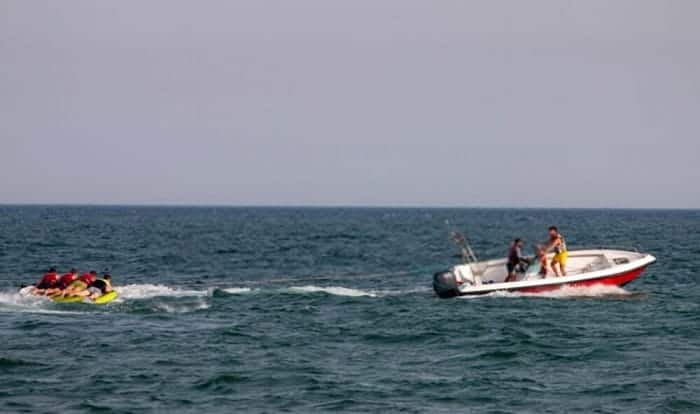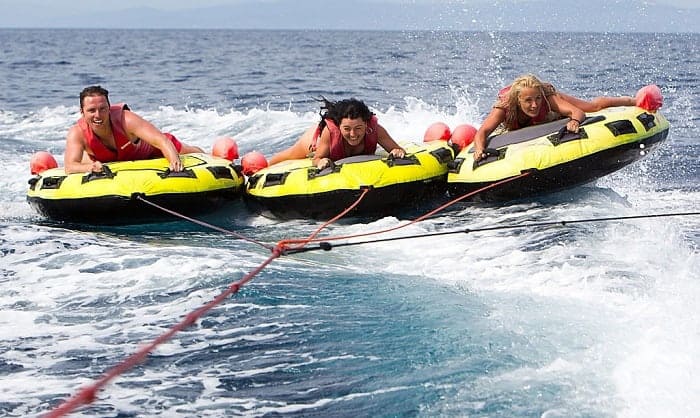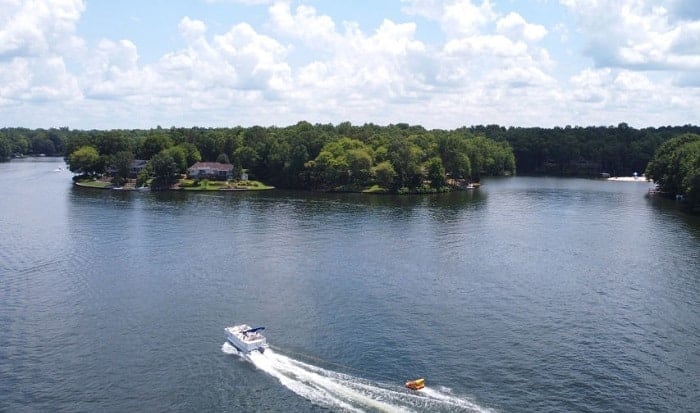Spending the weekend with family and friends over watersports is a great idea. This recreational activity is a fun way of riding along the waves of the sea or a river. Riders are towed behind a boat and will surely enjoy every pull along the water.
It is crucial to know how to tow a tube behind a boat. Aside from maximizing the fun, this knowledge will also keep you away from injuries and other dangers in the water. Pulling the tube is not something that should frighten you. It is also an exciting way to keep your riders enjoying the ride while being safe as a driver.
Table of Contents
What You Need For This Tutorial
There are several things to keep in mind while towing the tube in the water. As a driver, you need to have a few safety measures before getting on the boat. Here are the materials required to tow a tube behind a boat carefully:
1. Boat
There is a great variety of boats that can tow a tube. Cruisers, pontoons, ski boats, and deck boats are among the few examples that can properly tow your line. Before getting aboard your boat, make sure that it is fueled, and it has been working fine.
2. Tube
Ensure that the tube is reliable on the body of water where you will do watersports. Check for holes on the line if there are any. Adequately inflate the tube before having fun.
3. Towing Rope
A recommended towing rope for tubing is sold in a lot of watersport outlets. These ropes have a little ‘give’ in them for more enjoyable tubing. A knot-free rope should be used for tubing.
4. Life Jackets
Everyone in the water is preferred to have a safety life jacket for a secure activity. The driver, the rider, and the spotter should wear this protective garment before getting aboard.
5. Rear View Mirror
Experts recommend that drivers to have a rearview mirror on the boat. This mirror will be a visual cue for the driver on where his tube riders are. It will help him make sure that the riders are safe and still on the tube while being on the water.
6. Helmets
Although most tubing activities do not advocate for helmets on the water, this protective gear is essential for the riders. This gear will avoid harmful impact on the head in cases of falls or head collision with other tubers. It also protects the ears, especially on water splashes.
Steps to Tow a Tube behind a Boat
Step 1: Inflate the Tube
The first thing that you will need for this watersport is to have the tube ready and well-inflated. The right pressure on the tube will avoid collapse while on water. Ensure that the tube has no holes nor any areas for potential holes or malfunctions.
The place where the tow line is should also be safeguarded for any damages before riding. Know the maximum weight capacity of the tube. It is also essential to know the age recommendations and the number of people on the line before driving.
Step 2: Tie the Tow Rope Securely
Make a slip knot on the boat’s end where the tow rope is securely placed. The bar should be stable to keep the cord from always moving while driving. On the tube’s end, hook up the tow rope properly.
There is a variation of the rope handles for each line, so you should follow the manufacturers’ recommendations beforehand. Inspect both ends before riding.
The rope should have no knots, sun damage, nor any signs of fraying. Check for rope entanglements. It should be free from the propeller below, any object nearby, and on the body of the rider. Although this might be an obvious step, some injuries may occur because people fail to check the rope’s connections and knots.
Step 3: Follow the Instructions on the Boat Manual
The boat has its manual. The driver should know how to operate the boat, make turns, and break. The driver has control of the entire watersport activity. The emergency buttons and other control options must function well before getting on the boat. The map should be at hand; at this point, you can install the rearview mirror at the best angle and location of the boat.
Step 4: Wear the Life Jacket and Helmet
Let the riders, the spotter, and the driver wear the life jacket appropriately. Even though you know how to swim, it is precautionary to have a life jacket to avoid drowning. Let the riders wear helmets at this point. There are also safety rules and regulations, depending on the state and water park where you go. If not all, most will recommend everyone to wear a protective life jacket before every tubing activity.
Step 5: Make sure the riders are ready.
Before the throttle, make sure the riders are safe and ready for the tubing activity. They should have worn the life jacket and helmet beforehand. By this time, you can also review the hand signals to ensure good communication while on board.
Step 6: Drive Slowly and Surely
Enjoy the water, and drive responsibly. It is pertinent for the driver to be sober and to be mentally sharp while driving the boat. Keep the inflatable on the water; the speed should not exceed 20 miles per hour.
Some waterparks have regulations on the rate of motorboats. The driver should know their rules, any shore or fixed object on the route, and other vessels that are enjoying the waterpark.
PRO Tips
- Know the hand signals in advance. Teach the riders these signals to have good communication before getting aboard the boat and the tube. The driver, spotter, and riders should all be knowledgeable of these hand signals.
- The driver should be fully awake and knowledgeable of the route. Knowing if there are other vessels on the same course is also recommended.
- Avoid horseplay while on the tube. Remind the passengers to hold onto the tube, and avoid standing up or other activities that are not recommended while riding it.
- Do not tow multiple inflatables. Avoid pulling other watersports like skis and boards at the same time.
- Do not pull over large waves. This activity might look fun, but it can harm the passengers and might result in injuries.
Conclusion
Did you enjoy reading this mini tutorial on how to tow a tube behind a boat carefully and correctly? It is essential to follow these steps and tips to avoid injuries while on water. These steps are curated to keep you safe while still enjoying your time on the tube. What do you think of these simple steps?
If you are eager to hop on a tube, share this article with your friends so that they will be aware of these steps. These tips will help you feel secure while enjoying your quality time outdoors.

“I am James Harvey – founder of Boating Basics Online. It is established with the drive to help out first-time boaters, which are those desiring to explore their way through the water. So if you are new to boating, start from here with me. “



